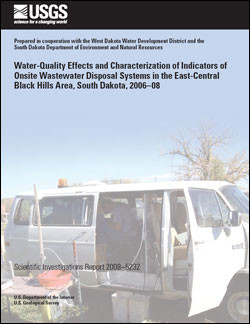
Product Details
- Product Number
- 357348
- Series
- SIR-2012-5158
- Scale
- NO SCALE
- Alternate ID
- SIR-2012-5158
- ISBN
- 978-1-4113-3453-3
- Authors
- KARL R KOTH
- Version Date
- 01/01/2012
- Regions
- SD
- Countries
- USA
- Media
- Paper
- Format
- Bound
Additional Details
- Description
-
Abstract
A study of groundwater storage in the karstic Madison aquifer in the Black Hills of South Dakota using microgravity methods was conducted by the U.S. Geological Survey in cooperation with West Dakota Water Development District, South Dakota Department of Environment and Natural Resources, and Lawrence County. Microgravity measurements from 2009 to 2012 were used to investigate groundwater-storage changes and effective porosity in unconfined areas of the Madison aquifer. Time-lapse microgravity surveys that use portable high-sensitivity absolute and relative gravimeters indicated temporal-gravity changes as a result of changing groundwater mass. These extremely precise measurements of gravity required characterization and removal of internal instrumental and external environmental effects on gravity from the raw data. The corrected data allowed groundwater-storage volume to be quantified with an accuracy of about plus or minus 0.5 foot of water per unit area of aquifer. Quantification of groundwater-storage change, coupled with water-level data from observation wells located near the focus areas, also was used to calculate the effective porosity at specific altitudes directly beneath gravity stations.
Gravity stations were established on bedrock outcrops in three separate focus areas for this study. The first area, the Spring Canyon focus area, is located to the south of Rapid City with one gravity station on the rim of Spring Canyon near the area where Spring Creek sinks into the Madison aquifer. The second area, the Doty focus area, is located on outcrops of the Madison Limestone and Minnelusa Formation to the northwest of Rapid City, and consists of nine gravity stations. The third area, the Limestone Plateau focus area, consists of a single gravity station in the northwestern Black Hills located on an outcrop of the Madison Limestone. An absolute-gravity station, used to tie relative-gravity survey data together, was established on a relatively impermeable bedrock outcrop to minimize groundwater-storage change at the reference location.
Data from the three focus areas allow for interpretation of groundwater-storage characteristics using microgravity measurements. Gravity measurements, together with water-level data from an observation well located 2 miles from the Spring Canyon focus area and measured streamflow in Spring Creek, provided evidence that rapid groundwater-storage change, responding to changes in sinking streamflow over the recharge area of the aquifer, occurred in the Madison aquifer directly beneath the gravity station at Spring Canyon. This phenomenon likely was a result of groundwater movement through caverns, conduits, and fractures, which are common in karst aquifers. Spatially and temporally separated microgravity data for the Doty focus area indicated horizontal and vertical heterogeneity of effective porosity for the Madison aquifer. One such example of this was indicated by water-level measurements at an observation well and gravity measurements at four gravity stations in the southeastern part of the Doty area, which were used to estimate effective porosity values ranging from greater than 0 to 0.18. A decrease in groundwater storage determined by microgravity measurements during the spring recharge period for five upgradient stations in the Doty focus area indicated the possibility of rapid release and downgradient cascading of perched groundwater. Evidence for similar phenomena was documented for Wind Cave and Brooks Cave in the Black Hills. Absolute-gravity measurements at the Limestone Plateau focus area confirmed the relation between water levels in an observation well and changes in groundwater storage. Comparison of these gravity measurements with water levels in a nearby observation well resulted in an effective porosity estimate of 0.02 for the Madison aquifer beneath the gravity station.
- Print Date
- 2012
- Height In Inches
- 11.000
- Width In Inches
- 0.100
- Length In Inches
- 8.500
- Two Sided
- Yes
- Pieces
- 1
- Languages
- English




